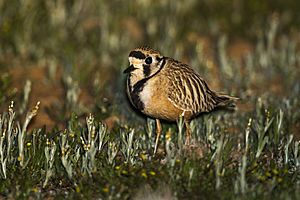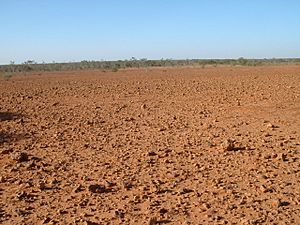Inland dotterel facts for kids
Quick facts for kids Inland dotterel |
|
|---|---|
 |
|
| Conservation status | |
| Scientific classification | |
| Genus: |
Peltohyas
|
| Species: |
australis
|
 |
|
| Distribution of inland dotterel | |
| Synonyms | |
|
Charadrius australis |
|
The inland dotterel (Peltohyas australis) is a special type of shorebird that lives only in the dry, central parts of Australia. It usually stays in small groups in areas with sparse plants, like flat, stony plains or dry clay areas. During the day, it rests in the shade and eats small plant shoots. At night, it's more active, often looking for insects on roads. Because its home is so remote, scientists haven't studied it much.
Contents
About the Inland Dotterel
The inland dotterel is a medium-sized bird with unique colours that help it blend in. Both male and female birds are about the same size. They are typically 19–23 cm (7.5–9 in) long. Their wingspan is about 43–47 cm (17–19 in), and they weigh around 80–90 g (2.8–3.2 oz). They also have a short bill, about 1.7 cm (0.67 in) long.
It's hard to confuse this bird with others in its natural home. Its top feathers are a sandy brown colour with dark brown spots. It has a special black band across its head that goes down through its eye. Its face, neck, and belly are white. A wide black Y-shaped band stretches from its back neck, down the sides of its neck, across its chest, and to the middle of its belly. Below this band, its chest and sides are sandy brown. Its legs are pale, but its feet are darker. It has dark brown eyes and a short, dark bill.
Male and female birds look very similar. They change to a lighter, less colourful plumage when they are not breeding. Young birds don't have the strong black markings on their head, neck, and chest that adult birds do. This bird doesn't call often. When it does, it's usually a short, quiet "quick" or a rough "kroot" sound as it flies away. Baby dotterels are covered in short, soft, downy feathers. These are pinkish-buff or cream on top with many dark brown blotches. Their undersides are off-white, and their bill and legs are pale yellow.
History and Classification
The inland dotterel was first discovered in 1840. Captain Charles Sturt found a young bird during one of his trips into Australia's dry interior. He sent it to John Gould, a famous bird expert. Gould first named it Eudromias australis. The name Eudromias comes from Greek words meaning "good runner," and australis means "of the southern continent."
The inland dotterel is one of over 60 types of shorebirds in the Charadriidae family, even though it rarely lives near water. How scientists classify this bird has been debated. Its first scientific name suggested it was related to the Eurasian dotterel, but this isn't true. Most experts now place it in its own special group, called Peltohyas.
Where They Live
The inland dotterel lives across the dry parts of south-east and south-west Australia. You can find it in suitable areas in all the mainland states. Its home matches areas that get very little summer rainfall.
Habitat
Inland dotterels like areas with few plants. They prefer places with low bushes like saltbush or bluebush, which are about 200–400 mm (7.9–15.7 in) tall. These plants give them food and shelter. They are most often seen on flat, stony plains (called gibber plains), dry clay areas (clay pans), and gravel flats. It's thought that these birds have actually benefited from land being cleared for farming after European settlers arrived.
We don't know much about how they move around. They seem to travel south in spring and north in summer. They might also move outside their usual areas if there's too much rain or a very bad drought, making their homes unsuitable. Some birds have even been seen as far away as Sydney, New South Wales.
Behaviour and Life Cycle
During the day, these birds usually gather in loose groups of 10 to 20 birds, sometimes even hundreds. They are generally quiet and inactive during the day, though they might eat plants. As evening comes, the group spreads out. Most of their activity happens at night when individual birds hunt for different insects. This is why people often see them on outback roads at night. They can handle hot temperatures, but they will look for shade if it gets hotter than 40 degrees Celsius (104 degrees Fahrenheit). If someone approaches them, they prefer to run away rather than fly.
Food
During the day, inland dotterels eat the soft tips of desert shrubs. These birds have special glands above their eyes that help them remove salt from the plants. This means they can get water from the plants they eat. Sometimes, large groups of them gather at water tanks and clay pans to drink. At night, their diet changes to insects. Scientists have found spiders, grasshoppers, beetles, ants, and earwigs in their stomachs.
Reproduction
When it's time to breed, inland dotterels form pairs and stay together. Both parents help take care of the young. They might breed alone or in small groups of up to six nests. It's believed they can breed at any time of year if the conditions are right. However, not much is known about their breeding habits in the wild, as most information comes from birds kept in zoos.
The nest is a shallow dip in the bare ground. The birds either make it themselves or use a natural dip. They usually lay three eggs. The eggs are oval-shaped and medium brown, with an uneven pattern of dark brown spots. They are about 3.7 cm by 2.7 cm in size.
Threats
In the inland dotterel's dry desert home, there aren't many major threats. However, Foxes (Vulpes vulpes) have been seen eating their eggs and young. Also, Black falcons (Falco subniger) and nankeen kestrels (Falco cenchroides) have been seen attacking adult birds.
Parasites
Two types of tiny parasitic lice have been found on inland dotterels: Austromenopon sp. and Quadraceps neoaustralis.
Conservation Status
While there aren't exact numbers, it's believed that the inland dotterel population is quite large and stable across its range. The IUCN has classified it as a least concern species. This means it is not currently at risk of extinction. It is not listed as threatened by any Australian Federal or State laws, but it is listed as vulnerable on Victoria's advisory list of threatened animals.
Images for kids
See also
 In Spanish: Chorlito australiano para niños
In Spanish: Chorlito australiano para niños





